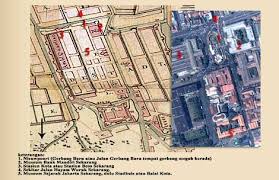 |
Welcome to the Jakarta History Museum, or Museum Fatahillah. Built in 1620, with occupied area of 13 thousand square meters, the building style of architecture ancient 17th century consists of the main building with two wings in the east and west and near a building used as offices, court rooms, and spaces down land that is used as a prison.
Previously, the VOC era, this building is called Stadhuis or Stadhuisplein used by the Dutch government buildings as Balaikota, when the Dutch central government still in power in Indonesia to end on 30 March 1974, by the Indonesian government, this building and inaugurated as a museum Fatahillah.
Located at Jalan Taman Fatahillah No. 2, West Jakarta, the museum store is many things that can be told from the past. Start from Jakarta travel history, results of archaeological excavation in the area of Jakarta, antique furniture from the 18-th century, ceramic, gerabah, to a stone inscription. These collections are located in different rooms, such as prehistoric Jakarta Room, Room Tarumanegara, Jayakarta Room, Room Fatahillah, Sultan Agung space, and space MH Thamrin. There are also various collections of the Betawi culture, numismatik, and pedicab. Even now also placed a statue of god Hermes (the Greek mythology, the god of fortune and protection of trade), which was located in Harmony perempatan cannon and Si have a robust force that is considered magical.
In the past, in addition to functioning as Balaikota, the building is also used as a prison. There is a former prison that was under the ground used to throw those who violate the rule of law the Dutch. I wonder, fighter-combatants such as Prince Diponegoro Indonesia, never inhabit this prison. Terrain in front of the Museum of History of Jakarta, known as Taman Fatahillah, is a silent witness the hanging execution of the implementation of China's thousands of people involved in the rebellion against the Dutch in 1740 years.
Fatahillah Museum is just one of the langkanya old and historic buildings in the capital, the silent witness to the struggle of the Indonesian people against the Dutch government at that time. Building Museum Fatahillah this, menorehkan many memories for those who lived, and only a drop in the tempo DOELOE. Until now the museum is still visited. Not only by local tourists, but also by foreign tourists, especially European tourists.
Museum is open daily Tuesday through Sunday, starting at 09.00-15.00 wib. While the museum is closed to the public on Sunday and feast day.
How to Achieve this Region
This museum can be achieved by using the busway (Blok M "City of), private vehicles, taxis, and public transport.

Place Stay
 In many hotels that can be a choice as the place you stay. If you'd like more close to the Old Town area of Jakarta, you can make the hotels around the area of your consideration, such as the Omni Batavia Hotel, Le Grandeur Hotel (Dusit Mangga Dua), Mangga Dua Novotel, Sheraton and others.
In many hotels that can be a choice as the place you stay. If you'd like more close to the Old Town area of Jakarta, you can make the hotels around the area of your consideration, such as the Omni Batavia Hotel, Le Grandeur Hotel (Dusit Mangga Dua), Mangga Dua Novotel, Sheraton and others.You can mengeliligi Museum Fatahillah walk to see the museum collection.
Dining place
In the east door of the main museum Fatahillah, there is a cafe called Cafe Museum. Cafe is a facility of the Museum companion Fatahillah old buildings by utilizing the colonial architecture, so that regulation is tailored interior with trinkets that remind us in the colonial period. Interesting that this cafe's menu is a list of foods that Betawi tempo nuances DOELOE affected some cultures, such as Chinese, Arabic and Dutch. Start from the portuguese steak, ong tjai ing, kwee tiaw, tuna sandwich "van zeulen", "east indies" chef's, soup "Ali Martak", until the fish Bawal "the pitung" and fried banana "Nyai Dasima" available at this cafe.
No comments:
Post a Comment
You have the impression and comments for products and services, you may want to share with comment. I am glad if you comment can benefit you and please do not spam.